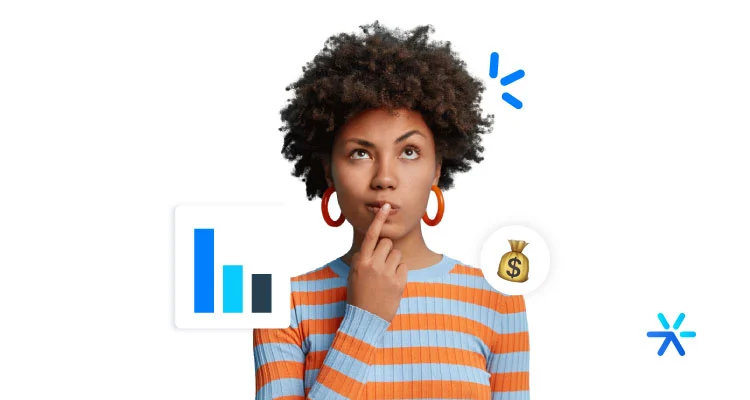Social Proof: Definition, Types + 12 Tips
Social proof is used by many companies as a way to enhance and validate marketing strategies, presenting the benefits and unique features of the offered solution through the voice of satisfied customers.
It’s undeniable that a recommendation from someone we trust influences how we consume. Besides a personal recommendation, there are other influences, such as the opinions of people we admire and follow on social media, the information we consume in the media, and the reviews we read online. All these factors impact what we think, desire, and how we act, especially regarding our consumption habits.
Want to better understand what social proof in marketing is, why it works, and how to use it in your company’s communication? Check out all the details now!
What Is Social Proof?

Social proof is a persuasive tool used to convince a potential client to actually make a purchase or sign a contract with your company. Thus, we can say that social proof is based on the concept of social influence.
With a testimonial or validation from someone who already knows the brand and has benefited from the offered solution, credibility increases, and the decision-making process is driven forward.
How Does Social Proof Work?
We can explore social proof as a sales argument and a means of persuasion, as consumers need this kind of hook to choose between specific products or brands.
But does social proof in marketing really work as well as people assume?
The thing is, humans generally need help making decisions. And why does this happen?
Well, it’s as if our brain needs factors that assure the benefits of a decision, so that we can proceed with it or not.
Therefore, our decisions are always influenced by the following points:
- Scale – We think about the number of people who acted in a certain way;
- Ambiguity – We question how the experience of those who acted that way was;
- Similarity – We assess the degree of similarity between those who acted and ourselves;
- Attraction – The opinion of family and friends is always considered;
- Authority – Besides the opinion of friends and family, we also consider the opinion of experts in the field.
From this, we can conclude that we almost always need to mirror our decisions based on past experiences, whether they are ours or from others.
Only then can we decide whether that decision is reliable or not. In other words, social proof in marketing is the perfect material to compare experiences and then make decisions.
What Are the Main Types of Social Proof?

We have selected 7 types of social proof that are widely used by companies, and you can also use them as sales arguments for your brand.
Leia também: 9 Gatilhos Mentais para Vendas que Ainda Funcionam em 2022
Case Study
Presenting social proof with data and statistics is one of the most effective ways to use this validation argument.
It’s particularly common in the B2B sector, as it demonstrates the results obtained by clients. And you know how important results are.
If you already have a client who achieved some gain or metric improvement after acquiring your product or service, build and publish case studies that tell that story.
Leadster itself has case studies that can help you understand more about this type of social proof in marketing. Check out our Case Studies.
Testimonial
Simple, short, and personal — testimonials from satisfied customers regarding a product or service are applicable to virtually all segments and types of solutions.
Don’t forget to include names, job titles, and photos to increase the credibility of the testimonials.
Reviews
Reviews are forms of social proof primarily used in cases of products or solutions that can be purchased online, as those searching for reviews are more inclined to complete the purchase, just doing the final research before making a decision.
However, they are not restricted to just this use.
If you have the opportunity to include reviews on your social media profiles and website, don’t miss out.
Also, check out other review-specific platforms, such as Reclame Aqui and Google itself, as well as segment-specific sites like Trip Advisor for hospitality, for example.
Social Media
What people say about your brand on social media has never had as much power and relevance for consumers, especially in B2C markets.
You can even use positive mentions and interactions as a form of validation and showcase satisfied customers as part of your posts.
Read Also: 36 Ready-to-Use Copywriting Templates to Overcome the Fear of a Blank Page
Authority Icons
Using logos and icons of clients, especially when they are big market players, adds strength to your business and shows that selective companies trust you. You can also showcase the media outlets that have mentioned your solution to demonstrate your brand’s reach.
Business Numbers
Another common way to explore social proof is to gather data related to your company’s performance:
- How many years in the market;
- How many clients;
- How many projects or products delivered;
- How many people impacted by your solutions.
All this data is relevant.
Visitor and Follower Numbers
Still exploring numbers, when we talk about social media and online environments, the number of website visitors and social media followers can also serve as social proof. This method is widely used by media outlets, digital influencers, and content-producing companies, for example.

What Are the New Types of Social Proof?
In addition to the most common and widely used types we mentioned, there are still less obvious ways to include social proof in your communication and marketing materials. They are:
Storytelling
If you are building a page or material correctly, it should present a cohesive story for each of your visitors.
You can include social proof as a component in the sales storytelling, as part of the language that composes the content.
Implicit Social Proof
You can also explore a sales argument with social proof without making it so explicit to the visitor who is providing that validation information.
This doesn’t mean you can use random data, but in this case, the data is more impactful than the person behind the social proof.
Activity-Based Social Proof
You can be even more specific by presenting social proof from satisfied clients and specifying what situation or pain point they used your product or service for.
This is a way to create even more identification between the visitor and those who already consume your product and validate it.
How to Use Social Proof on Instagram?
If you are a small or medium business and still don’t have a website to publish your social proof, invest in Instagram.
In Brazil alone, the social network has over 29 million active users per month.
In other words, in addition to reaching a large audience, your social proof will have a much more direct contact with the user, potentially deepening relationships.
To do this, invest in posts, stories, and reels that showcase your clients’ satisfaction. It could be a success case, positive feedback, or a compilation of good reviews — use what your company has best to offer.
Which Types of Social Proof Work Best?

There is no single answer to this question. Ultimately, the social proof that delivers the best results for your business will be considered the most effective.
However, some data collected by BrightLocal shows which social proofs have the best metrics.
Check it out:
- 88% of consumers trust user reviews as much as personal recommendations.
- Adding client logos to the company website can increase conversions by up to 400%.
- Influencer marketing is the fastest-growing consumer acquisition channel.
- Consumers read an average of 10 online reviews before making a decision.
- 57% of consumers will only buy or use a service if it has at least a 4-star rating.
For 50% of all consumers, the next step after reading a positive review about a company is visiting its website.
Why Is Social Proof Important?
Using this type of tool offers several benefits, especially if you understand what is relevant to your persona. Check out the main reasons to leverage social proof in your communication strategy.
Authority
Adding high-quality social proof means increasing your brand’s credibility with the audience. When this validation comes from someone they identify with or admire, it boosts confidence and reinforces your positioning as an authority within your field of expertise.
Acceptance
Positive testimonials and reviews also increase acceptance of your product or service, especially for those who are not yet familiar with your solution or brand. Acceptance opens the door for your brand to build a relationship with this visitor and, in the future, increase conversion rates.
Transparency
Including social proof shows that your company is open to receiving feedback and is not afraid to show potential clients what actual consumers think about buying from you.
In addition to conveying transparency, this action also demonstrates maturity and confidence.
Conversions
All these points ultimately result in greater confidence for the consumer to complete a purchase or contract. Social proof improves conversion rates since with opinions, case studies, testimonials, and reviews, the visitor or lead already knows what to expect after becoming a client of your business.
How to Obtain and Apply Social Proof?

Are you eager to start including social proof in your strategy and enjoy all these benefits? Here’s how you can gather this information and turn it into sales arguments.
Open Space for Reviews
On social media, product pages, and even blog comments, you can open the space for consumers to share their opinions and suggestions about their experience.
On Facebook, for instance, this feature already exists for any page; you just need to activate it.
Seek Account Verification
Still on social media platforms like Facebook, Twitter, and Instagram, you can try to get your page verified.
This is a way to add implicit social proof and increase your company’s credibility. Contact the support team for each social network to verify the rules for making the request.
Encourage Testimonials
Send surveys to your customers, encouraging them to participate.
You can create contests, offer rewards, or even benefits on a future purchase. This way, the number of participants will increase.
Use Only the Best Social Proof
If you have a closer relationship with some clients or access to those who have been purchasing from your company for a long time or with a certain frequency, start gathering testimonials from them.
If they have a stronger relationship with your brand, they will likely have something positive to say about it.
Ask Assertive Questions
When creating surveys and interaction hooks, know how to ask the right questions.
For case studies, also pay attention to standardizing the questions so that the structure is familiar to those searching for all published examples.
Highlight Client Data and Numbers
Numbers make information more rational and present results in a tangible way to your prospects.
Invest in Storytelling
Tell compelling stories when presenting your company’s social proof. This way, you engage visitors and make the acceptance of the testimonial even higher.
Share Important Milestones
Sharing and celebrating significant moments for the company and achieved goals can also bring the audience closer and encourage interaction.
Examples include reaching visitor, follower, or user milestones; brand anniversaries; acquiring new clients, etc.
Build Partnerships
You can explore partnerships with other companies, opinion leaders, or your most loyal clients.
Having recognized authorities in the field alongside you will certainly bring great reputation to your brand.
Be Honest
Your social proof must be real and honest. Without these two criteria, they are worthless. Visitors and users can easily tell when the proof is fabricated.
Use Inspiring Images
Social proof with images conveys more credibility and generates a higher level of identification. If possible, include photos of your clients alongside their testimonials.
Leverage Your Remarketing
Targeting those who have already visited your pages with social proof may be what was missing to turn that visitor into a client.
Explore social proof in this highly targeted type of ad. You now understand that using social proof stimulates purchasing decisions and adds credibility to your solution.
Now, you need to think about the best way to implement social proof in your marketing strategy.
To do this, let’s return once more to copywriting. Learn now how to write persuasively while also using your social proof and putting into practice the combination of copywriting and digital marketing!







